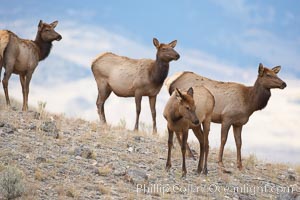
Small group of female and juvenile elk.
Species: Elk, Cervus canadensis
Location: Mammoth Hot Springs, Yellowstone National Park, Wyoming
Image ID: 19758
Species: Elk, Cervus canadensis
Location: Mammoth Hot Springs, Yellowstone National Park, Wyoming
Image ID: 19758
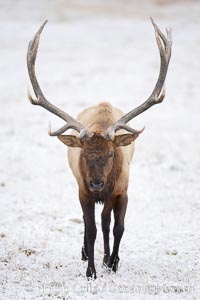
Large male elk (bull) in snow covered meadow near Madison River. Only male elk have antlers, which start growing in the spring and are shed each winter. The largest antlers may be 4 feet long and weigh up to 40 pounds. Antlers are made of bone which can grow up to one inch per day. While growing, the antlers are covered with and protected by a soft layer of highly vascularised skin known as velvet. The velvet is shed in the summer when the antlers have fully developed. Bull elk may have six or more tines on each antler, however the number of tines has little to do with the age or maturity of a particular animal.
Species: Elk, Cervus canadensis
Location: Yellowstone National Park, Wyoming
Image ID: 19767
Species: Elk, Cervus canadensis
Location: Yellowstone National Park, Wyoming
Image ID: 19767
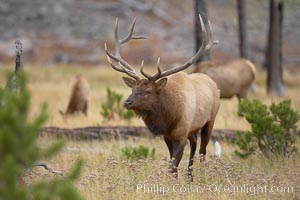
Elk, bull elk, adult male elk with large set of antlers. By September, this bull elk's antlers have reached their full size and the velvet has fallen off. This bull elk has sparred with other bulls for access to herds of females in estrous and ready to mate.
Species: Elk, Cervus canadensis
Location: Yellowstone National Park, Wyoming
Image ID: 19773
Species: Elk, Cervus canadensis
Location: Yellowstone National Park, Wyoming
Image ID: 19773
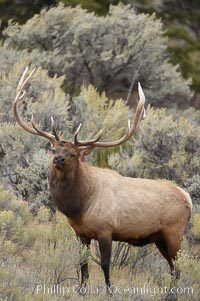
Bull elk in sage brush with large rack of antlers during the fall rut (mating season). This bull elk has sparred with other bulls to establish his harem of females with which he hopes to mate.
Species: Elk, Cervus canadensis
Location: Mammoth Hot Springs, Yellowstone National Park, Wyoming
Image ID: 19779
Species: Elk, Cervus canadensis
Location: Mammoth Hot Springs, Yellowstone National Park, Wyoming
Image ID: 19779
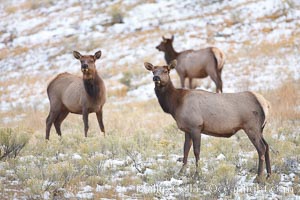
Female elk in early autumn snowfall.
Species: Elk, Cervus canadensis
Location: Mammoth Hot Springs, Yellowstone National Park, Wyoming
Image ID: 19762
Species: Elk, Cervus canadensis
Location: Mammoth Hot Springs, Yellowstone National Park, Wyoming
Image ID: 19762
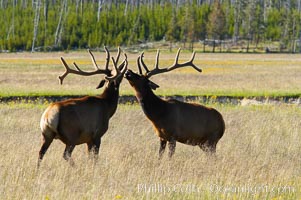
Bull elk spar to establish harems of females, Gibbon Meadow.
Species: Elk, Cervus canadensis
Location: Gibbon Meadows, Yellowstone National Park, Wyoming
Image ID: 13152
Species: Elk, Cervus canadensis
Location: Gibbon Meadows, Yellowstone National Park, Wyoming
Image ID: 13152
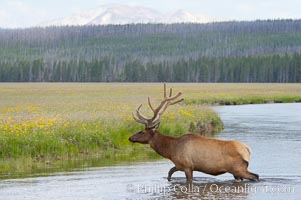
Elk in the Gibbon River.
Species: Elk, Cervus canadensis
Location: Gibbon Meadows, Yellowstone National Park, Wyoming
Image ID: 13153
Species: Elk, Cervus canadensis
Location: Gibbon Meadows, Yellowstone National Park, Wyoming
Image ID: 13153
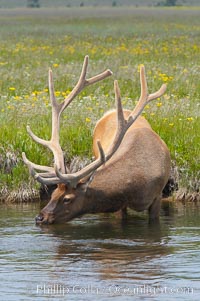
Elk in the Gibbon River.
Species: Elk, Cervus canadensis
Location: Gibbon Meadows, Yellowstone National Park, Wyoming
Image ID: 13156
Species: Elk, Cervus canadensis
Location: Gibbon Meadows, Yellowstone National Park, Wyoming
Image ID: 13156
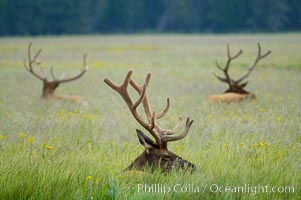
Elk rest in tall grass during the midday heat, Gibbon Meadow.
Species: Elk, Cervus canadensis
Location: Gibbon Meadows, Yellowstone National Park, Wyoming
Image ID: 13157
Species: Elk, Cervus canadensis
Location: Gibbon Meadows, Yellowstone National Park, Wyoming
Image ID: 13157
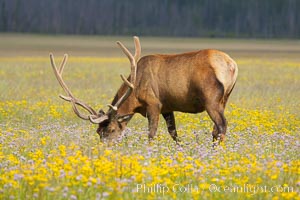
Elk graze and rest among wildflowers blooming in the Gibbon Meadow, summer.
Species: Elk, Cervus canadensis
Location: Gibbon Meadows, Yellowstone National Park, Wyoming
Image ID: 13158
Species: Elk, Cervus canadensis
Location: Gibbon Meadows, Yellowstone National Park, Wyoming
Image ID: 13158
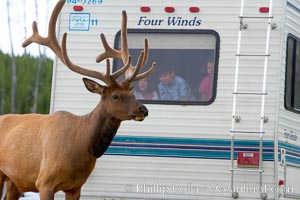
Tourists get a good look at wild elk who have become habituated to human presence in Yellowstone National Park.
Species: Elk, Cervus canadensis
Location: Yellowstone National Park, Wyoming
Image ID: 13160
Species: Elk, Cervus canadensis
Location: Yellowstone National Park, Wyoming
Image ID: 13160
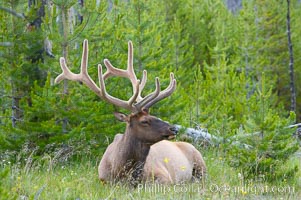
Bull elk, antlers bearing velvet, Gibbon Meadow. Elk are the most abundant large mammal found in Yellowstone National Park. More than 30,000 elk from 8 different herds summer in Yellowstone and approximately 15,000 to 22,000 winter in the park. Bulls grow antlers annually from the time they are nearly one year old. When mature, a bulls rack may have 6 to 8 points or tines on each side and weigh more than 30 pounds. The antlers are shed in March or April and begin regrowing in May, when the bony growth is nourished by blood vessels and covered by furry-looking velvet.
Species: Elk, Cervus canadensis
Location: Gibbon Meadows, Yellowstone National Park, Wyoming
Image ID: 13162
Species: Elk, Cervus canadensis
Location: Gibbon Meadows, Yellowstone National Park, Wyoming
Image ID: 13162
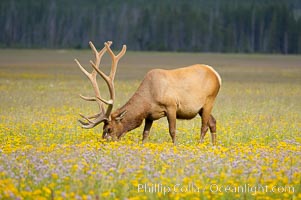
Elk grazing among wildflowers in Gibbon Meadow.
Species: Elk, Cervus canadensis
Location: Gibbon Meadows, Yellowstone National Park, Wyoming
Image ID: 13163
Species: Elk, Cervus canadensis
Location: Gibbon Meadows, Yellowstone National Park, Wyoming
Image ID: 13163
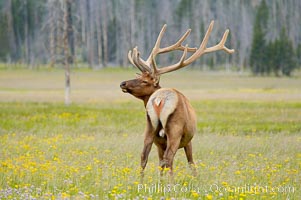
Bull elk, antlers bearing velvet, Gibbon Meadow. Elk are the most abundant large mammal found in Yellowstone National Park. More than 30,000 elk from 8 different herds summer in Yellowstone and approximately 15,000 to 22,000 winter in the park. Bulls grow antlers annually from the time they are nearly one year old. When mature, a bulls rack may have 6 to 8 points or tines on each side and weigh more than 30 pounds. The antlers are shed in March or April and begin regrowing in May, when the bony growth is nourished by blood vessels and covered by furry-looking velvet.
Species: Elk, Cervus canadensis
Location: Gibbon Meadows, Yellowstone National Park, Wyoming
Image ID: 13165
Species: Elk, Cervus canadensis
Location: Gibbon Meadows, Yellowstone National Park, Wyoming
Image ID: 13165
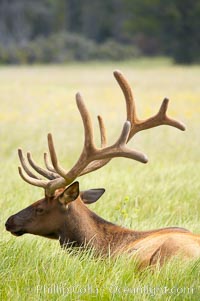
Bull elk, antlers bearing velvet, Gibbon Meadow. Elk are the most abundant large mammal found in Yellowstone National Park. More than 30,000 elk from 8 different herds summer in Yellowstone and approximately 15,000 to 22,000 winter in the park. Bulls grow antlers annually from the time they are nearly one year old. When mature, a bulls rack may have 6 to 8 points or tines on each side and weigh more than 30 pounds. The antlers are shed in March or April and begin regrowing in May, when the bony growth is nourished by blood vessels and covered by furry-looking velvet.
Species: Elk, Cervus canadensis
Location: Gibbon Meadows, Yellowstone National Park, Wyoming
Image ID: 13166
Species: Elk, Cervus canadensis
Location: Gibbon Meadows, Yellowstone National Park, Wyoming
Image ID: 13166
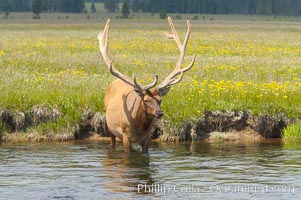
Elk in the Gibbon River.
Species: Elk, Cervus canadensis
Location: Gibbon Meadows, Yellowstone National Park, Wyoming
Image ID: 13167
Species: Elk, Cervus canadensis
Location: Gibbon Meadows, Yellowstone National Park, Wyoming
Image ID: 13167
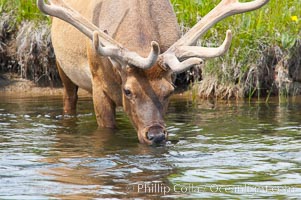
Elk in the Gibbon River.
Species: Elk, Cervus canadensis
Location: Gibbon Meadows, Yellowstone National Park, Wyoming
Image ID: 13168
Species: Elk, Cervus canadensis
Location: Gibbon Meadows, Yellowstone National Park, Wyoming
Image ID: 13168
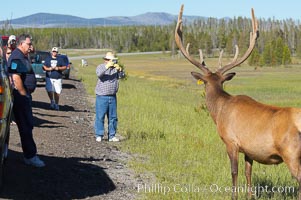
Tourists get a good look at wild elk who have become habituated to human presence in Yellowstone National Park.
Species: Elk, Cervus canadensis
Location: Yellowstone National Park, Wyoming
Image ID: 13169
Species: Elk, Cervus canadensis
Location: Yellowstone National Park, Wyoming
Image ID: 13169
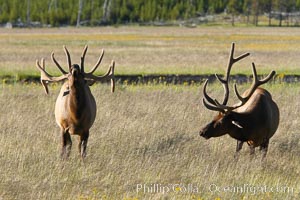
Bull elk spar to establish harems of females, Gibbon Meadow.
Species: Elk, Cervus canadensis
Location: Gibbon Meadows, Yellowstone National Park, Wyoming
Image ID: 13170
Species: Elk, Cervus canadensis
Location: Gibbon Meadows, Yellowstone National Park, Wyoming
Image ID: 13170
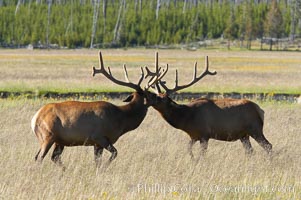
Bull elk spar to establish harems of females, Gibbon Meadow.
Species: Elk, Cervus canadensis
Location: Gibbon Meadows, Yellowstone National Park, Wyoming
Image ID: 13171
Species: Elk, Cervus canadensis
Location: Gibbon Meadows, Yellowstone National Park, Wyoming
Image ID: 13171
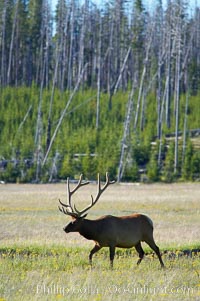
Bull elk, antlers bearing velvet, Gibbon Meadow. Elk are the most abundant large mammal found in Yellowstone National Park. More than 30,000 elk from 8 different herds summer in Yellowstone and approximately 15,000 to 22,000 winter in the park. Bulls grow antlers annually from the time they are nearly one year old. When mature, a bulls rack may have 6 to 8 points or tines on each side and weigh more than 30 pounds. The antlers are shed in March or April and begin regrowing in May, when the bony growth is nourished by blood vessels and covered by furry-looking velvet.
Species: Elk, Cervus canadensis
Location: Gibbon Meadows, Yellowstone National Park, Wyoming
Image ID: 13172
Species: Elk, Cervus canadensis
Location: Gibbon Meadows, Yellowstone National Park, Wyoming
Image ID: 13172
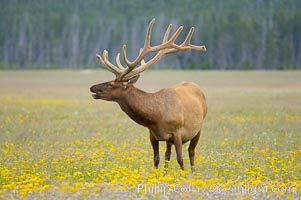
Bull elk, antlers bearing velvet, Gibbon Meadow. Elk are the most abundant large mammal found in Yellowstone National Park. More than 30,000 elk from 8 different herds summer in Yellowstone and approximately 15,000 to 22,000 winter in the park. Bulls grow antlers annually from the time they are nearly one year old. When mature, a bulls rack may have 6 to 8 points or tines on each side and weigh more than 30 pounds. The antlers are shed in March or April and begin regrowing in May, when the bony growth is nourished by blood vessels and covered by furry-looking velvet.
Species: Elk, Cervus canadensis
Location: Gibbon Meadows, Yellowstone National Park, Wyoming
Image ID: 13173
Species: Elk, Cervus canadensis
Location: Gibbon Meadows, Yellowstone National Park, Wyoming
Image ID: 13173
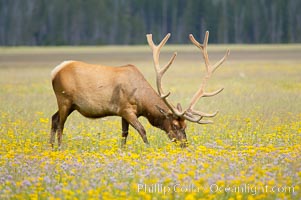
Elk grazing among wildflowers in Gibbon Meadow.
Species: Elk, Cervus canadensis
Location: Gibbon Meadows, Yellowstone National Park, Wyoming
Image ID: 13174
Species: Elk, Cervus canadensis
Location: Gibbon Meadows, Yellowstone National Park, Wyoming
Image ID: 13174
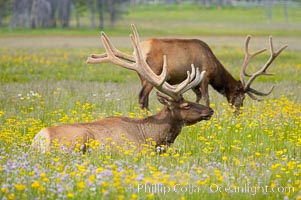
Elk rest in tall grass surrounded by wildflowers, Gibbon Meadow.
Species: Elk, Cervus canadensis
Location: Gibbon Meadows, Yellowstone National Park, Wyoming
Image ID: 13175
Species: Elk, Cervus canadensis
Location: Gibbon Meadows, Yellowstone National Park, Wyoming
Image ID: 13175
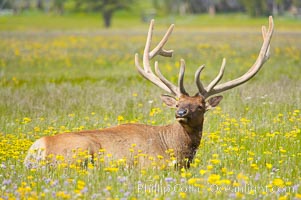
Elk rest in tall grass surrounded by wildflowers, Gibbon Meadow.
Species: Elk, Cervus canadensis
Location: Gibbon Meadows, Yellowstone National Park, Wyoming
Image ID: 13176
Species: Elk, Cervus canadensis
Location: Gibbon Meadows, Yellowstone National Park, Wyoming
Image ID: 13176
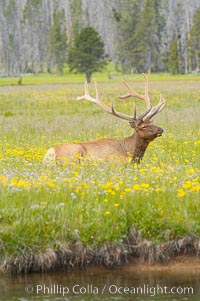
Elk rest in tall grass surrounded by wildflowers, Gibbon Meadow.
Species: Elk, Cervus canadensis
Location: Gibbon Meadows, Yellowstone National Park, Wyoming
Image ID: 13177
Species: Elk, Cervus canadensis
Location: Gibbon Meadows, Yellowstone National Park, Wyoming
Image ID: 13177
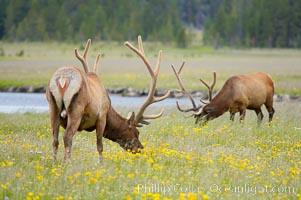
Elk grazing among wildflowers in Gibbon Meadow.
Species: Elk, Cervus canadensis
Location: Gibbon Meadows, Yellowstone National Park, Wyoming
Image ID: 13178
Species: Elk, Cervus canadensis
Location: Gibbon Meadows, Yellowstone National Park, Wyoming
Image ID: 13178
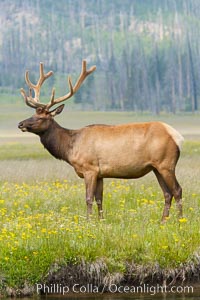
Bull elk, antlers bearing velvet, Gibbon Meadow. Elk are the most abundant large mammal found in Yellowstone National Park. More than 30,000 elk from 8 different herds summer in Yellowstone and approximately 15,000 to 22,000 winter in the park. Bulls grow antlers annually from the time they are nearly one year old. When mature, a bulls rack may have 6 to 8 points or tines on each side and weigh more than 30 pounds. The antlers are shed in March or April and begin regrowing in May, when the bony growth is nourished by blood vessels and covered by furry-looking velvet.
Species: Elk, Cervus canadensis
Location: Gibbon Meadows, Yellowstone National Park, Wyoming
Image ID: 13179
Species: Elk, Cervus canadensis
Location: Gibbon Meadows, Yellowstone National Park, Wyoming
Image ID: 13179
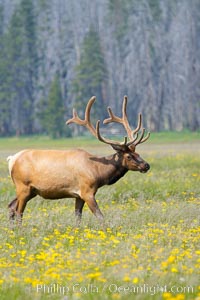
Bull elk, antlers bearing velvet, Gibbon Meadow. Elk are the most abundant large mammal found in Yellowstone National Park. More than 30,000 elk from 8 different herds summer in Yellowstone and approximately 15,000 to 22,000 winter in the park. Bulls grow antlers annually from the time they are nearly one year old. When mature, a bulls rack may have 6 to 8 points or tines on each side and weigh more than 30 pounds. The antlers are shed in March or April and begin regrowing in May, when the bony growth is nourished by blood vessels and covered by furry-looking velvet.
Species: Elk, Cervus canadensis
Location: Gibbon Meadows, Yellowstone National Park, Wyoming
Image ID: 13180
Species: Elk, Cervus canadensis
Location: Gibbon Meadows, Yellowstone National Park, Wyoming
Image ID: 13180
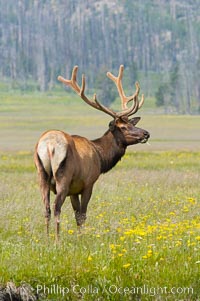
Bull elk, antlers bearing velvet, Gibbon Meadow. Elk are the most abundant large mammal found in Yellowstone National Park. More than 30,000 elk from 8 different herds summer in Yellowstone and approximately 15,000 to 22,000 winter in the park. Bulls grow antlers annually from the time they are nearly one year old. When mature, a bulls rack may have 6 to 8 points or tines on each side and weigh more than 30 pounds. The antlers are shed in March or April and begin regrowing in May, when the bony growth is nourished by blood vessels and covered by furry-looking velvet.
Species: Elk, Cervus canadensis
Location: Gibbon Meadows, Yellowstone National Park, Wyoming
Image ID: 13181
Species: Elk, Cervus canadensis
Location: Gibbon Meadows, Yellowstone National Park, Wyoming
Image ID: 13181